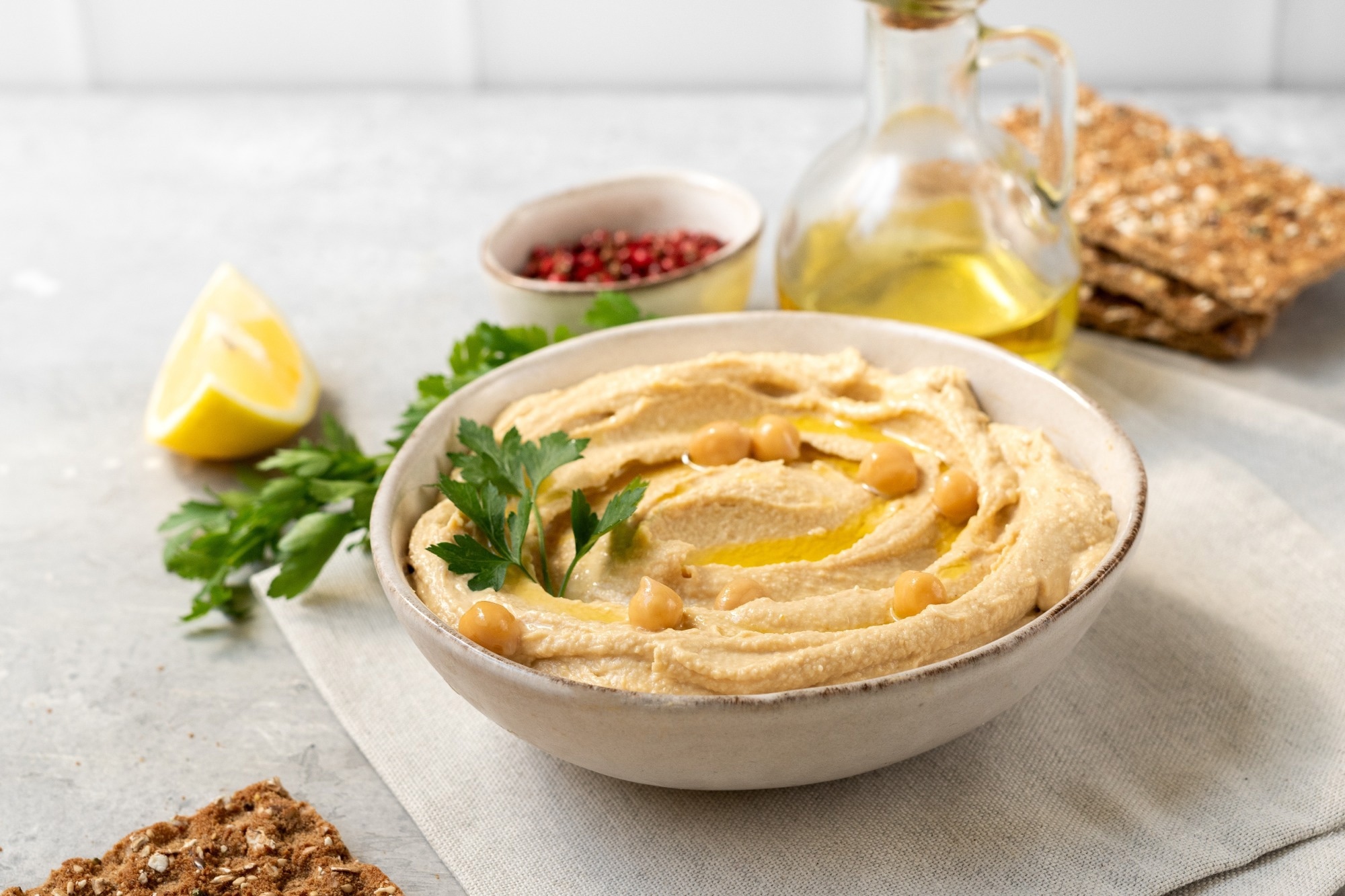Scientists show that lamb-infused hummus packs more protein, iron, and flavor while staying fresher, offering flexitarians and athletes a nutrient-rich twist on the classic dip.
 Study: Physicochemical, Nutritional, and Structural Characterization of a Novel Meat-Based Hummus. Image credit: Elena.Katkova/Shutterstock.com
Study: Physicochemical, Nutritional, and Structural Characterization of a Novel Meat-Based Hummus. Image credit: Elena.Katkova/Shutterstock.com
A recent Foods study assessed the physicochemical, nutritional, and structural characteristics of meat-based hummus prepared by incorporating 50% cooked minced mutton along with 0.4% sodium acid sulphate (SAS), a U.S. FDA “Generally Recognized as Safe (GRAS) additive and EPA-designated “Safer Choice” antimicrobial.
Why do we need meat-based hummus?
Hummus is a traditional Middle Eastern chickpea-based delicacy with a rich flavor and nutritional profile. However, ready-to-eat hummus can be high in sodium, which may contribute to elevated blood pressure and increased cardiovascular risk. A second concern with ready-to-eat hummus is its allergenicity. Allergens such as wheat gluten may provoke mild to severe allergic reactions in sensitive individuals.
The bioavailability of nutrients such as iron, vitamin B12, and zinc, used to fortify commercially available ready-to-eat hummus, is often lower than that from animal sources. Furthermore, the quantity of fermentable carbohydrates (FODMAPs) in chickpeas is high, which may lead to discomfort from gas and bloating in individuals with irritable bowel syndrome. Hummus has also been linked to food safety issues; between 2002 and 2017, 17 outbreaks of foodborne illness in the U.S. were associated with hummus, underscoring its vulnerability to pathogens like Salmonella, E. coli, and Listeria. This stimulated research into developing a meat-based hummus.
Red meat is a rich source of bioavailable heme iron and vitamin B12, which is particularly important for children, pregnant women, athletes, and the elderly. Combining legumes and meat could offer a nutritionally richer meal, blending fiber and phytochemicals with absorbable minerals and complete amino acids.
About the study
The present study aims to assess a novel formulation of meat-based hummus, using SAS as a natural preservative. Legs from three lambs were used with an approximate lean level of 85%. Chickpea seeds were soaked in water overnight and then cooked in a pressure cooker for 25–30 minutes. Pre-weighed quantities of all ingredients, i.e., pressure-cooked lamb, cooked chickpeas, olive oil, tahini, salt, lemon juice, freshly minced garlic, and water, were blended into a smooth paste. Granules of antimicrobial SAS were also added to the paste. The granules of SAS were pulverized and evenly mixed to ensure uniform distribution.
The meat-based hummus (50% chickpeas and 50% minced lamb) with 0.4% SAS as a preservative was compared to the traditional hummus with no SAS or minced lamb. In addition to the pH, the microbiological quality was assessed using the total plate count (TPC) on day 0 and day 7. To analyze color, L* (lightness indicator), a* (redness indicator), and b* (yellowness indicator) values were noted. The prepared hummus also underwent nutritional and sensory evaluation.
Study findings
The pH of the meat-based hummus was comparatively lower than that of the traditional hummus, which could be due to the acidic influence of SAS. In traditional hummus, b* and L* values were higher than meat-based hummus, possibly driven by the natural pigmentation from chickpea starch and leguminous fibers. The myoglobin content of lamb could partially explain the darker hue of meat-based hummus. Redness values were similar between the two types of hummus.
TPC was similar at day 0; however, on day 7, TPC was significantly lower in the meat-based hummus. This highlighted SAS’s antimicrobial action on microorganisms over the storage period. Meat-based hummus showed a 12.5% increase in total calories, 20% increase in total fat, and 66.6% increase in protein, relative to traditional hummus. The former also had higher amounts of cholesterol and saturated fat.
Meat-based hummus contained heme iron, which is more bioavailable than the non-heme iron in chickpeas, even though total iron content was similar (1 mg per serving). Traditional hummus also provides higher total carbohydrates and calcium, and lower sodium. Meat-based hummus had a modest sodium increase (150 mg vs. 130 mg per serving), partly from SAS and meat’s intrinsic sodium.
Scanning electron microscopy (SEM) revealed fundamental physicochemical contrasts between traditional and meat-based hummus. The former showed a porous, open network structure with loosely bound particles and irregular voids. The consistency was gel-like and spreadable, potentially driven by starches, polysaccharides, and soluble fibers. In contrast, meat-based hummus showed a fibrous, compact, and densely structured matrix. There were fewer voids and tightly bound protein aggregates, potentially because of cross-linked muscle fibers and acid-induced protein gelation from SAS.
Concerning sensory scores, there was no difference between traditional and meat-based hummus in appearance and color. The grain properties, flavor, creaminess, and mouth-coating scores for meat-based hummus were higher. The higher sensory score of meat-based hummus could be attributed to the fatty acid content of lamb and the umami profile.
Conclusions
The results documented in this study highlight that while traditional hummus has more carbohydrates, calcium, and fiber, meat-based hummus contains a higher amount of fat, protein, saturated fat, and bioavailable iron content. It also has slightly higher sodium and cholesterol, which should be considered by individuals monitoring these nutrients. In terms of flavor, creaminess, and overall acceptability, meat-based hummus scored higher than traditional hummus.
In sum, the results suggest that flexitarians could benefit from the development of food products that combine meat- and plant-based ingredients. Meat-based hummus supports growth and muscle recovery, and could be beneficial for athletes, young children, and women with higher nutritional requirements. However, the study notes that future research with larger sensory panels and longer storage testing is needed to confirm its shelf stability and broad consumer acceptance.
Download your PDF copy now!
Journal reference:
- Goswami, M. et al. (2025) Physicochemical, Nutritional, and Structural Characterization of a Novel Meat-Based Hummus. Foods. 14(14), 2507. https://doi.org/10.3390/foods14142507 https://www.mdpi.com/2304-8158/14/14/2507